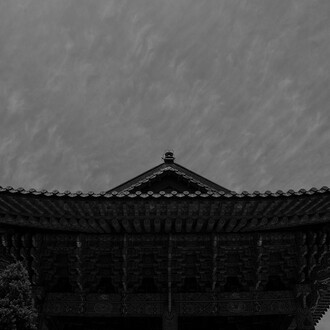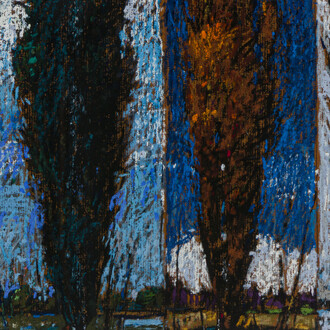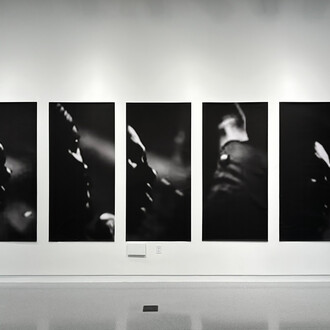David Richard Gallery is pleased to present the work of Rebecca Allan and Dean Fleming in a two-person exhibition, Landscape Medicine, opening Wednesday, June 12th and continuing through July 13th. The exhibition title refers to the artists’ shared dedication to revealing the majesty of landscape and the power of the natural world to open us to deeper levels of perception and attentiveness to our surroundings. For Allan and Fleming, soil is also a unifying, metaphorical material that is regarded by each artist as a life-sustaining substance.
Allan (b. 1962), is a New York-based painter, writer, and horticulturist who is known for her gestural and chromatically nuanced abstract paintings. Her work has been influenced by her travels throughout the Northeast, Pacific Northwest, New Mexico, Kentucky, Florida’s Gulf Coast, Lebanon, France, and Norway and is inspired by her interest in botany, geology, and landscape conservation. The artist’s studio overlooks the Spuyten Duyvil, at the confluence of the Harlem and Hudson Rivers in The Bronx.
Dean Fleming (b. 1933) is a painter and a founder member of the Park Place Gallery, an important artist collective and exhibition space in lower Manhattan in the early 1960s. Fleming is also a founder member of Libre, an intentional community of artists in southern Colorado where he currently lives. His vibrant paintings use geometry as a means to symbolize his deep engagement with nature, his experiences of indigenous cultures in the United States, as well as a metaphorical record of his extensive travels through Asia, Africa, Central and South America, and Europe. With the exception of a period in the 1970s that was marked by a more gestural approach and strong calligraphic influences from his travels to Japan earlier in that same decade, Fleming has had a longstanding commitment to geometric abstraction.
While traveling across the United States 1966, Fleming witnessed an Ute Indian Sun Dance in Ignacio, Colorado that had a profound effect on the artist. Seeing this moving ritual inspired Fleming to return to nature, to find an alternative model of peace, harmony and simplicity, and to devote his art to a spirit of thanksgiving. From this initial experience came the impetus for Libre—meaning “free” in Spanish—the intentional artist community where, according to Fleming, “We built our own houses, grew our own food, delivered our children and followed our bliss.”
The exhibition includes Allan's paintings that emerge from her experiences as a collections assistant at Kykuit/The Rockefeller Estate, and previously, as a plant records manager at a private garden north of New York City where she witnessed the labor and artistry of gardeners who cultivate, tend, harvest, and prune rare collections of Japanese maples, conifers, vegetable and perennial gardens. Piles of cut branches, pruning tools, and debris became a visual leitmotif for the seasons of the year, and a metaphor for the effort that is required to maintain and to steward a landscape garden. These works complement Allan's ongoing involvement as an advocate for land conservation through her role as an advisor to the Kentucky Natural Land Trust and the Cary Institute of Ecosystem Studies. Her environmental activism is also realized in her collaboration with the musicians and scientists of The Crossroads Project, thecrossroadsproject.org, a performance piece about climate change.
Fleming's paintings in this presentation reference the Medicine Wheel of the Lakota people, Native Americans and one of three Sioux tribes living in the Plains of the US. The Medicine Wheel, comprised of a circle that represents the earth’s boundary and referred to as the Sun Dance Circle, is a sacred symbol of the Plains people for the never-ending cycle of life and death. The pair of horizontal and vertical intersecting lines reference the path of the sun and man. As noted, the 1970s were a time of change for Fleming personally and aesthetically. After returning from Japan, Fleming suffered a personal tragedy with the death of his daughter. To “heal his heart” he traveled through Mexico, Guatemala and Central America living and working with indigenous peoples along that journey. Immersing himself in art and indigenous cultures, he identified with seeds and circles as ancient symbols for rebirth and life. Upon his return to Libre, Fleming returned to his calligraphic painting and Zen-inspired influences, which led to his focus on Native American symbols and remembering the overwhelming impact of his witnessing of the Ute Sun Dance more than a decade earlier. Respecting the land and loving his family and Libre, Fleming modified the Medicine Wheel to include circles of soil from Libre and white Dakota shale out of a prehistoric cave from the same area. He had fully embraced the Medicine Wheel and importance of the earth and cycle of life as his “perfect analogy for God”.
















